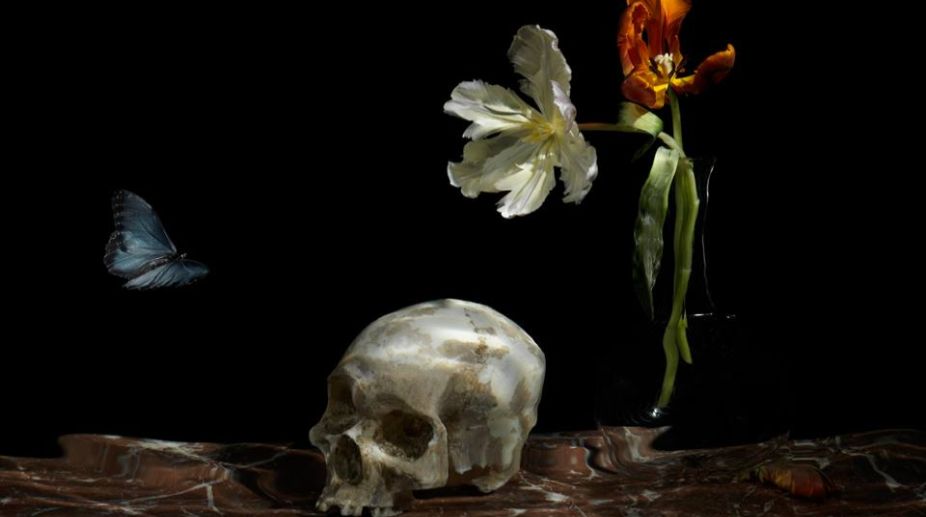Death is everywhere among the roses in an initially charmingly pretty but increasingly disconcerting exhibition, the first at Guildhall Art Gallery devoted to still life art: the lovely flowers are there, but so are bloody hunks of raw meat, a bullet fashioned from human bone and a cobwebby skull made from dust. “It’s death. It’s always been all about death,” curator Michael Petry said cheerfully.
“In the 17th century you looked at a vase of luscious blooms and everyone immediately got the message: this is the peak of perfection and beauty, it’s all downhill from here.That’s the element that is really hooking in contemporary artists.” Change and decay is a very practical issue with the skull made from a duster and glued household dust by the artist Paul Hazelton, titled ‘Fright Wig’ but startlingly resembling the late Andy Warhol.
“It is a conservation nightmare,” the Guildhall curator, Katherine Pearce, said, watching nervously for any dust being shed as the skull swayed slightly in its glass case. “And, of course, most of household dust is actually made up of human skin,” Petry added.
Advertisement
“So the circle is complete.” Darren Jones’s ‘A Time and a Place’ is also cause for anxiety – a collection of objects precariously balanced on a small glass shelf, representing a rollicking weekend in the gay bars and clubs of Fire Island off New York, including-ferry tickets, mouthwash, tissues, lubricant in a bullet shaped container, whiskey, paracetamol and a tape measure.
The exhibition, which opens next month, brings together scores of contemporary works including pieces by Michael Craig-Martin, Marc Quinn, and Mat Collishaw. They have been chosen by the artist, author and curator Petry and co-curator, artist and dancer Robert Ekholm, joining old master still life from the collection of the City of London, many coming out of decades in storage or previously admired only by guests at grand City dinners. Death is explicit in many of the contemporary pieces.
Collishaw’s work resembles a classic 17th-century Dutch still life, food piled up against a dark background – but it actually represents the last meal chosen by a real prisoner, Juan Soria, including chicken, fish and fresh fruit, before he was executed for murder in Texas. The state has since abandoned the tradition of offering prisoners their choice.
Petry, who has just published a Thames & Hudson book on still lifes, wants visitors to look more carefully at what artists are really saying when they choose it – the title of the exhibition is the French nature morte, literally “dead nature.” The simple outline of a leaf in one contemporary piece needs as careful a decoding as the lost language of flowers and religious symbolism in many of the historic paintings: the American artist Eric Rhein decided to make an image of a leaf for each of the people he knew who had died of Aids, and the maple leaf is for the photographer Robert Mapplethorpe. “We are more aware of death than ever now,” Petry said.
“A generation of young artists has grown up in the last two decades in the shadow of endless killing, nonstop war in Afghanistan, Iran, Iraq – and now we have two mad men with their fingers on the nuclear button.” Visitors to the exhibition may pass by three richly-coloured glass vases on marble plinths at the entrance without realising that they are the first exhibit, Petry’s own work. The colours of the vases and flowers relate to the gay code of coloured handkerchiefs to indicate sexual preference: the shapes in which the vases were moulded have an even more intimate meaning. “It will all be explained in the label,” Pearce said.
“This isn’t an exhibition where we’re shying away from anything edgy.” “Nature Morte” is being displayed at the Guildhall Art Gallery, London from 7 September 2017 to 30 April 2018
(Dawn/ANN)
Advertisement











